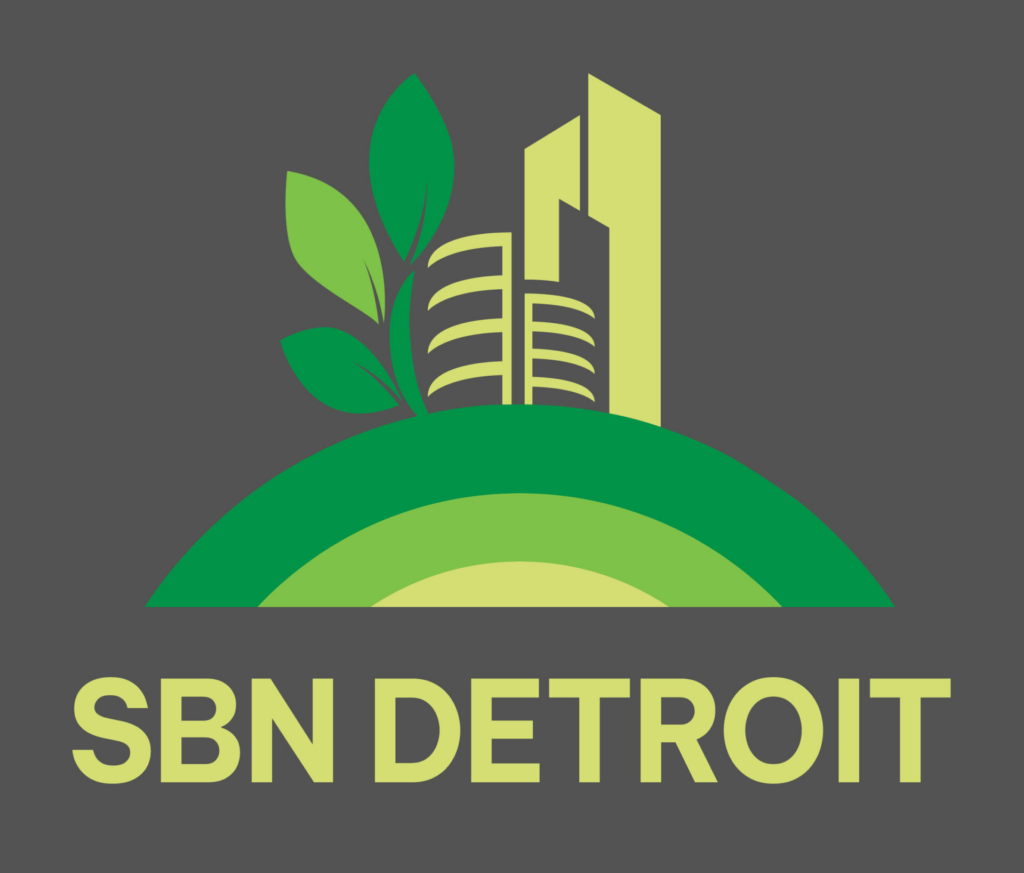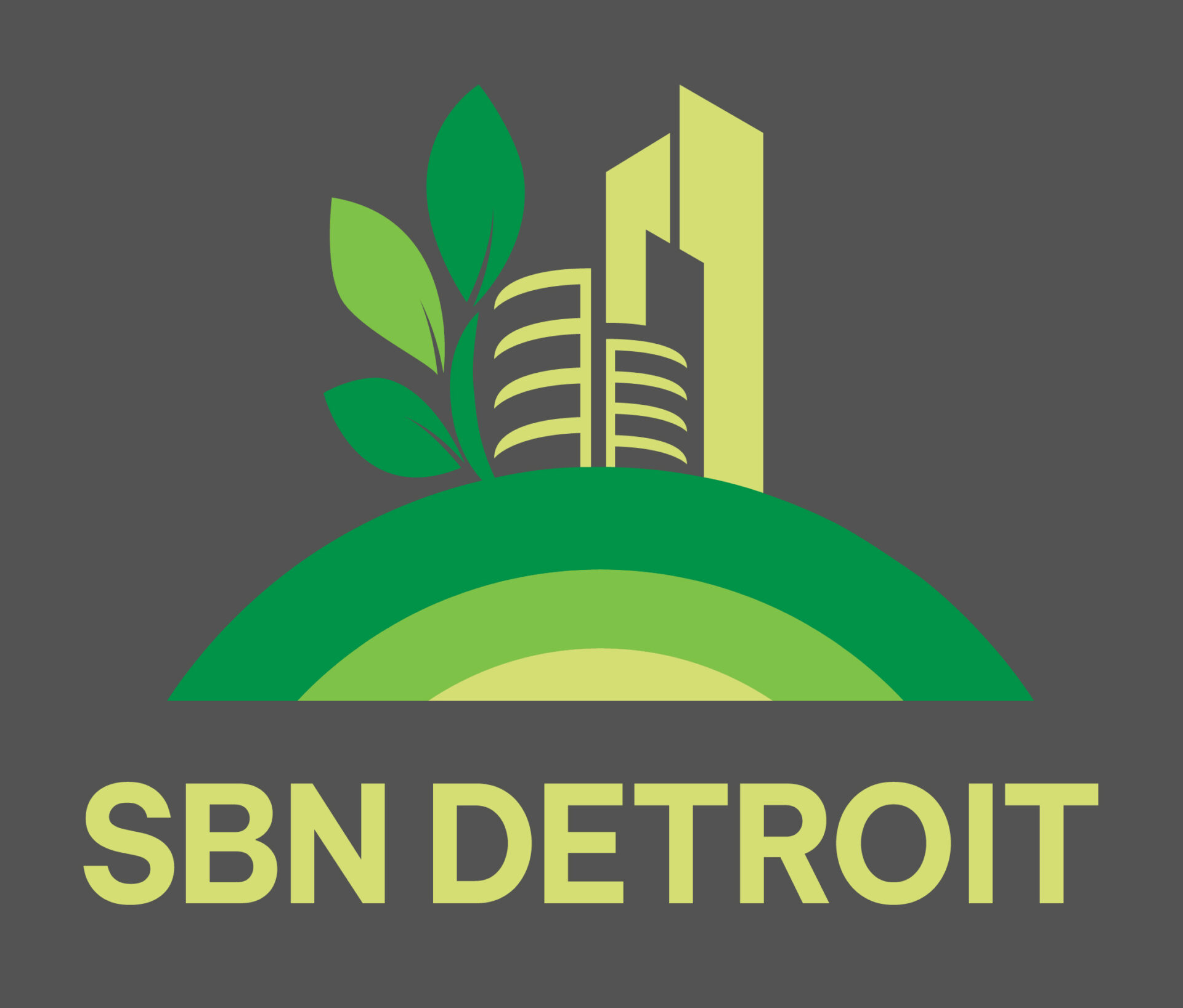Martinrea: Balancing Growth with Energy and Waste Reduction Goals
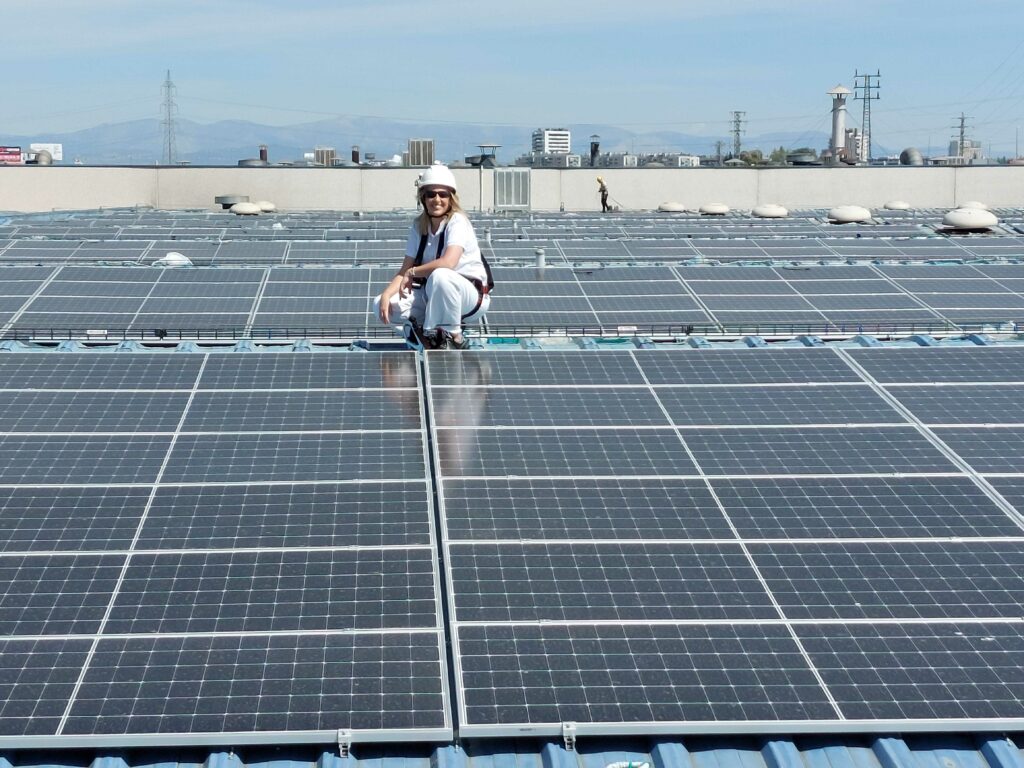
With over 19,000 employees working in 56 manufacturing, engineering, and technical centers in over 10 countries, Martinrea International is a global auto parts manufacturer focused on the design and development of lightweight structures and propulsion systems. Its sustainability goal is to operate in a socially responsible and ethical manner centered around respect for the environment, laws, universal human rights, and communities around the world. SBN Detroit spoke with Rachel Handbury, director of sustainability, to find out more about the company’s approach and execution. Q: How do you approach sustainability at Martinrea? A: Martinrea views sustainability as a holistic approach that encompasses both people and the planet. Our vision is to make lives better by being the best supplier we can be in the products we make and the services we provide. One of our ten guiding principles is to ultimately “leave It better.” Q: How is sustainability organized internally? A: There are a lot of different layers within Martinrea to achieve sustainability. It is embedded throughout the company from leadership to the manufacturing plants. We have a Sustainability Steering Committee, and the group holds quarterly meetings. This is led by our CEO, and his presence in the meetings drives the importance. We have a strong team working constantly on sustainability that meets weekly. This involves a sustainability lead from each of our four business units (Aluminum, Metallics, Flexible Manufacturing Group (FMG) and Fluids). We review each business unit’s sustainability targets, initiatives, and implementation. As you can imagine, each group drives their sustainability priorities slightly differently due to their different manufacturing processes. Q: In around 2019/2020, Martinrea hired a third-party consultant to assist with the sustainability strategy. How did that work? A: Martinrea utilized this consultant team to perform an internal materiality assessment, identify our stakeholders, and propose a sustainability strategy, which I was hired to manage. We then developed the business unit sustainability lead team and the Sustainability Steering Committee – the management structure needed to implement the sustainability strategy. Q: How do you get employees involved in sustainability? A: We do this in multiple ways. Education is key. The more our employees know about sustainability and how Martinrea supports sustainability, the more they want to incorporate it at work and in their homes. The fact that our leadership is on board is very important. It’s embedded from the top down and vice versa. Sustainability is also part of our internal business plan. We have implemented sustainability scorecards for the manufacturing plants and within each business unit, so everyone has clear sustainability targets they are looking to achieve. We also give out an annual ‘Leave it Better’ award to a plant that is excelling in all aspects of sustainability. The purpose is both to highlight the work being done and to foster involvement. The added benefit is that the winning plant inspires others to do similar work in their plant. Q: What are your short-term goals for 2024? A: We have a year-over-year goal of a 3% reduction in energy intensity (energy consumption relative to sales) in all operations. We also have a year-over-year absolute carbon reduction goal of 3%. This year we added internal water reduction goals, and we are working to reduce water consumption focusing on the plants located in high-water risk areas and plants that have the highest water usage. Q: What are your longer-term goals? A: 35% reduction in absolute carbon by 2035 without carbon credits, and we strive for every manufacturing plant to be zero landfill. Q: What are your biggest challenges? A: We are a growing company, so as our production increases, we have to balance that with continuing to achieve our reduction goals. Q: What are the biggest opportunities? A: Sustainability is very important to our customers and communities. We are an authentic company achieving our sustainability goals through energy efficiency and giving back to the communities in which we work and live. Our approach to sustainability provides a competitive advantage since our customers want to work with sustainable suppliers. Q: How are your suppliers vetted when it comes to sustainability? A: Suppliers are a big focus for us right now. Just as our customers view us as partners in sustainability, we also view our suppliers as partners. We have sustainability embedded in our supplier assessments and our supplier code of conduct. We are also providing more education to our suppliers so that they understand why it’s important to us and also to them. Some of our suppliers are in the early stages of sustainability and we can help to pull them along on this sustainability journey. Q: In 2022, Martinrea set a goal to reduce carbon emissions by 35% by 2035. How will you get there? A: It’s a multifaceted approach. But boiled down, we focus on reductions first. We need energy to produce parts, but we are looking at how we can use energy in the most efficient ways. The next stage is to look at renewable energy. In one of our plants in Spain, we just installed solar panels that provide 10% of the plant’s energy. Q: You have reduced carbon intensity by 19% since 2019 – how? A: This same strategy. We start with low-hanging fruit. There were significant reductions made by switching lighting to LED, simple changes in welding techniques, and more. It’s really about having eyes on the manufacturing process through the lens of sustainability and making changes. Q: What does the future look like? A: Following the strategy we’ve developed to push sustainability further each year, we will be utilizing innovation to accomplish energy and waste reductions, increasing efficiency, and then incorporating renewable energy, where possible. At Martinrea, it’s not about making broad claims, it’s about being authentic and digging deeper to see where we can make a difference, both for people and the planet. Be sure to subscribe to our newsletter for regular updates on sustainable business practices in and around Detroit.
A Look at EGLE’s Materials Waste Management Division
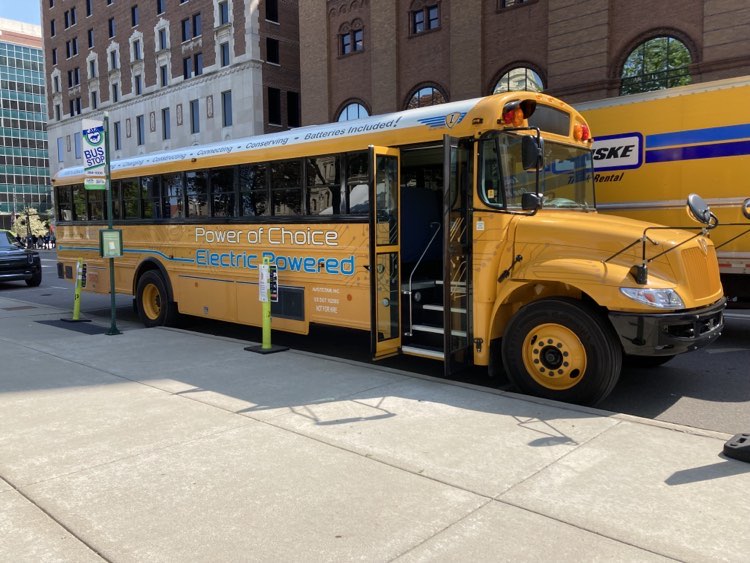
The Materials Management Division (MMD) of the Michigan Department of Environment, Great Lakes, and Energy (EGLE) oversees solid and hazardous waste programs, radioactive materials activities, a radon awareness program, recycling, and energy programs. We interviewed the director of the division, Elizabeth Browne, to get some insights. Q: How do you think energy efficiency, recycling, and pollution prevention are interconnected when it comes to fostering sustainability in Southeast Michigan? A: I have always felt you can’t have any without the others, and they are all key to having a sustainable system. Maybe it’s my biologist background. Recycling facilitates energy efficiency since it translates to diverting items from landfills. If you have a good system, you are reusing and recycling materials nearby, you save energy by not transporting material across state lines. When we look at energy efficiency, it works the same way. If we decrease the effort and resources put into heating, cooling, water usage, and transportation systems by becoming more efficient, we have more resources to allocate elsewhere. And isn’t that the very heart and definition of sustainability? Q: How do environmental justice and underrepresented communities factor into these efforts in Southeast Michigan? A: They factor in highly. There are federal funding requirements to help regulate this. The federal Justice 40 program deems that 40% of grant funds be used in underrepresented communities. Even before that, this was a focus for us. If you look at any of our requests for proposals, we pay special attention to projects coming from underrepresented communities – places where the community’s ability to be more sustainable has been stressed. We are always trying to level the playing field. Q: You work with state and federal partners, entrepreneurs, companies, organizations, and communities to reduce Michigan’s reliance on nonrenewable energy. Can you tell us more about this work? A: We work with federal partners in seeking every grant opportunity that we feel we have a nexus with. We work with companies and organizations through the Retired Engineers, Scientists, Technicians, Administrators, Researchers, and Teachers (RESTART) program. This is a group of retired professionals who work with entities to identify where they have energy issues or where renewable energy options may be a benefit. We do energy audits for houses of worship, schools, and municipal buildings. In many cases, these buildings are older and not efficient, so we offer ideas on how to improve efficiency and look at renewable options. This helps them save financial resources that they can then allocate elsewhere. We have received grant money through the Charge Up Michigan Program to install fast chargers in communities. Within this program, the cost of charger installation is divided amongst the location owner, the utility provider, and EGLE. This allows us to install more chargers, and it helps the utilities get closer to their energy efficiency goals and benefits the property owner or business. We have worked with communities to replace diesel- and gas-powered vehicles with electric ones, including Willow Run Airport and the City of Detroit. In Detroit, we replaced diesel-powered garbage trucks with EVs. We work heavily with NextCycle and the Centropolis Accelerator program at Lawrence Technological University. These are both programs to support businesses in their early stages. NextCycle is geared toward recycling activities, and the Centropolis Accelerator focuses on clean technology and the circular economy. Q: What are your biggest challenges in materials management? A: The thing that keeps me up at night is navigating grant programs. There is this huge influx of federal money, but there are a lot of checks and balances, and trying to manage the funding appropriately is a challenge. There is a lot of hurry-up-and-wait involved. We have a phenomenal team, and I don’t want to break their backs as they work to move the money out to recipients. Q: What are your highest priorities? A: Moving as much of the funding to those who need it and doing it in a way that is equitable and fair and hits the highest needs. Sometimes we make decisions that aren’t flashy, but the impact they have on that community is significant. A small community getting a few solar panels to help power their community building so the kids have someplace to go after school is a good example. We try to disburse the money in a way that supports as many communities and people as possible. Q: What does the future look like? A: I think it keeps getting brighter. The Michigan Legislature recently passed an eight-bill package that updates solid waste laws and will ensure we have sufficient landfill capacity. We just held our Virtual Michigan Materials Management Conference and had almost 600 people from 11 states represented. Getting EV chargers out across the state and seeing more and more interest in communities in terms of electrification is good progress. There is so much potential for economic growth in the energy and recycling fields. It’s astronomical. This excites me. Every day, I see people and companies that are looking for support and direction on becoming more sustainable. More and more companies understand the need to be sustainable because the public is demanding it, and it’s also for their own good. I encourage everyone to reach out to us. People interested in any EGLE grant programs can go to Michigan.gov\EGLE and search for “grants and financing.” For more information about all things Materials Management Division, our web pages can be found at Michigan.gov/EGLE/about/organization/materials-management. Be sure to subscribe to our newsletter for regular updates on sustainable business practices in and around Detroit.
NextEnergy: Working Toward Smarter, Cleaner, and Accessible Solutions for Communities and Cities
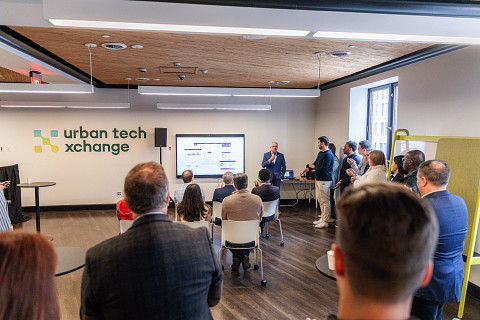
According to The World Economic Forum, the share of the world’s population living in cities is expected to rise to 80% by 2050, from 55% now. This increased density combined with an aging infrastructure, a growing digital divide, and other variables brings significant challenges in terms of supporting this increase in density. To address these challenges, NextEnergy works collaboratively to accelerate commercialization in mobility and energy efficiency. SBND interviewed Jim Saber, NextEnergy president and CEO, about its work. Q: Tell me about NextEnergy A: NextEnergy is a nonprofit corporation with a mission to accelerate smarter, cleaner, and more accessible solutions for communities and cities. We partner with innovators to facilitate the commercialization, testing, and deployment of technology in the energy and mobility spaces. We also work with the public sector to help educate on how these solutions can improve the quality of life for people who live, work, and visit their communities. Q: What is the impetus behind NextEnergy? A: Our focus has always been on creating and accelerating new use cases (how a product or service could be used), new applications, and new sectors for the state of Michigan. We were established in 2002 with funding from the Michigan Economic Development Corp. Our goals have remained consistent: To create new opportunities for Michigan to design, develop, and produce new solutions in energy and mobility. Q: Your services include project and program development, market business and trend research, consortium building, infrastructure assessment and design, and custom energy analysis. What are some examples of projects you are working on within these services? A: When it comes to project and program development, NextEnergy partners with Michigan-based companies from startups to Tier 1 automotive suppliers, and energy providers to develop collaborative programs to allow technology to move forward. We are also heavily involved in securing funds from the U.S. Departments of Commerce, Energy, and Transportation among others to bring new solutions to the market. Most recently we’ve been called on to manage two facilities on behalf of industries. These are the Detroit Smart Parking Lab (DSPL) and the Urban Tech Xchange (UTX). These facilities are set up to partner with industry innovators to test and demo new solutions in real-world environments. The DSPL is used to develop solutions for automated parking, charging, sensing applications, and more, to provide data to developers and city planners on how to manage spaces. This is a consortium between Bosch, Ford, Bedrock Detroit, and the Michigan Office of Future Mobility and Electrification. The Urban Tech Xchange operates in the same way, with a focus on the built environment. This is a consortium between Bosch, Bedrock Detroit, KODE Labs, and Cisco. On the market business and the research side, we help companies understand how their solutions best fit the market, assist with the best ways to go to market, who to partner with, how to work with the public sector, and more. When it comes to consortium building, an example of a project we are working on is the development and testing of components that allow for fast fueling of Class 8 trucks (33,001+ pounds), using hydrogen. Within the areas we focus on – mobility and energy – all of the new applications require additions and modifications to existing buildings and property infrastructure. Our team works with companies, cities, and communities to assess where solutions are best deployed, determine how to make them more cost-effective, and understand how best to design and execute, and how to bring it all together. Q: In what ways do you think NextEnergy is making a difference in Southeast Michigan when it comes to sustainability? A: Many of the companies we work with are in Southeast Michigan. I think the work we do to help these businesses bring new solutions and opportunities to market helps them to become more sustainable and employ more people. Outside of Southeast Michigan, we are working with MiNextCities to help create resilient communities in Dearborn, Marquette, and Flint. Q: Tell me about the work you are doing in Dearborn. A: The goal here is to improve community health and minimize the impacts of natural occurrences in the city. We have worked with the city on two areas: The first is planning and preparation to restore city services and mitigate losses from flooding as a result of storms. We’ve been able to partner with the city and companies to install technology that involves real-time sensing and AI monitoring of rising water within the stormwater system. This helps draw comparisons from past events to predict and then mitigate the impacts of flooding, saving the city and residents money, and minimizing health and energy impacts. The second focus in Dearborn has been on air quality. We partnered with Just Air – a startup in Detroit – that takes air quality measurements and brings them into a dashboard in a user-friendly way so that residents can get real-time information on air quality and determine if they should stay inside, etc. Q: In what other ways do you work on and impact sustainability? A: Part of our mission is to move forward solutions at the micro and macro levels that allow us to use less energy. Simply put, the most valuable kilowatt hour of energy is the one you don’t have to use. Creating new mobility applications and solutions for how we move people and goods is another way. Through the MEDC Office of Future Mobility and Electrification, we have been able to support innovators with local Michigan partners (investors, businesses, and communities) to deploy new mobility technology in the state. We have deployed tech in over 30 Michigan communities such as EV charging stations, automated vehicles, and applications that make mobility more accessible. We are affiliated with Michigan Clean Cities (MICC), which is part of a national network of Clean Cities Coalitions supported by the federal government. Its mission is to reduce dependence on fossil fuels for transportation and its work focuses on education, outreach, and community engagement. One of the newer
Newly Developed MiSide – Working to Build Sustainable Neighborhoods in Detroit
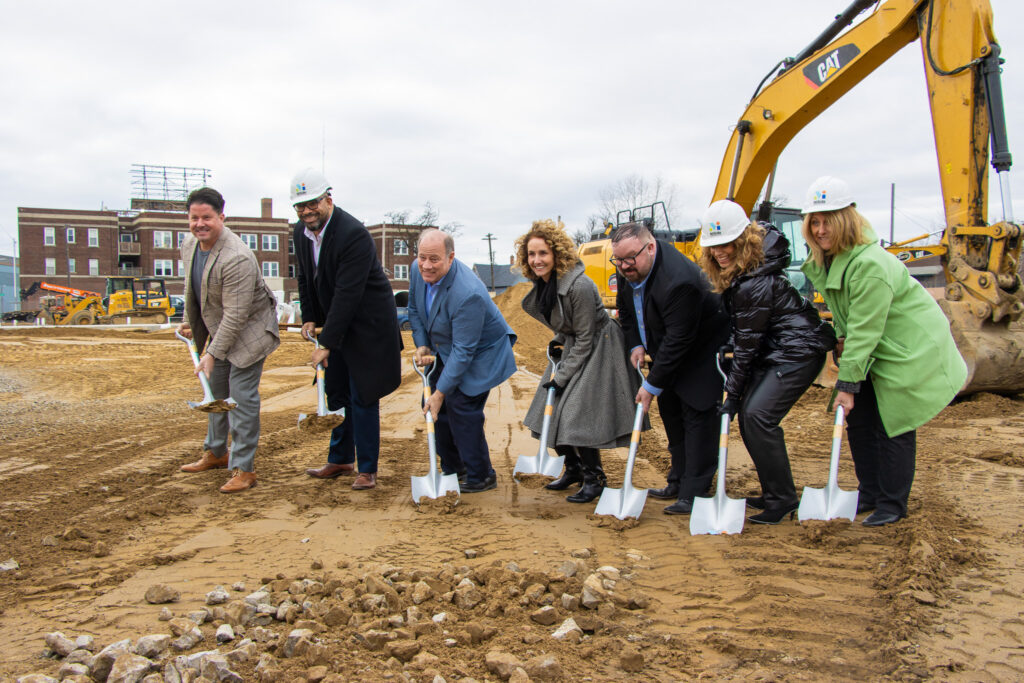
The MiSide Community Impact Network’s mission is to ensure that children, individuals, families, and communities have access to great healthcare, quality education, a comfortable home, and the money they need to build the life they desire. As such, their work is steeped in sustainability. SBN Detroit interviewed Timothy Thorland, executive director of MiHousing, and Hector Hernandez, executive director of MiWealth, to find out more. Q: What is the impetus behind the MiSide Community Impact Network? Thorland: It was formed (in late 2023) by two human service organizations in metro Detroit – Southwest Solutions and Development Centers Inc., which recognized that by combining they could offer a broader range of services to more low-to-moderate income families than either could alone. More importantly, both organizations understood that the families who seek them out for support are frequently facing multiple challenges and that a single organization would not be able to meet all of those needs. The service array now represented under MiSide can help with many of the most frequent challenges our families face – access to quality behavioral and physical health care, finding safe affordable housing, enrolling children in safe and affordable childcare, and gaining the skills to earn a good living. Q: MiSide’s mission is to provide individuals and communities with equitable access to health, education, self-sufficiency, and wealth accumulation opportunities. How do you think this mission plays out in terms of sustainability in the communities where you do your work? Thorland: One of the greatest predictors of sustainability for a community is stability in the community, and stability can’t happen for families unless the components outlined in MiSide’s mission are accessible to them. The way we’ve seen sustainable community improvements play out in our neighborhoods is through concentrated and coordinated services that start to transform a handful of families who reside in the area. As their circumstances improve, they stay in their neighborhood only if the environment around them begins to improve as well, and as long as they can continue to find what they need near them. So, working as part of the community to improve the housing stock, create anchors of affordability, avenues for homeownership, and wealth building must go hand-in-hand with the other services and supports we provide. With this collective approach, over time, whole neighborhoods and communities start to transform. Q: How does MiHousing lift the economy and facilitate equity and wealth building? Thorland: Over the past 25 years, MiSide Housing and its subsidiaries have developed more than 800 rental housing units, rehabilitated more than 1,000 single-family homes for homeownership, built and sold more than 100 homes for homeownership, facilitated scores of minor home repairs, developed more than 150,000 square feet of neighborhood office and commercial space, and originated more than 300 first or second mortgages, and beautified or improved more than 100 vacant land parcels – all together well more than $325 million of production. While our work has been predominantly in the affordable rental market, since 2011 we have been more actively engaged in single-family home ownership: First in the foreclosure/real-estate-owned market as a purchaser/rehabber/reseller of abandoned homes throughout Southeast Michigan; and, second, as a facilitator of down-payment assistance mortgages in partnership with NeighborWorks and Wells Fargo. While all of these programs contributed mightily in their own way to the economy, equity and wealth building most notably would be our third example. We have facilitated the transition of 53 tenants to becoming homeowners providing transactional guidance, support, homebuyer education, and a mortgage to help them achieve the dream of homeownership. Q: There is a project in the East Chadsey Condon neighborhood that just broke ground. What is the desired impact there? Thorland: The production of affordable housing is one of the top priorities in the state. In the Michigan Statewide Housing Plan released in 2022, the plan identified a need for 75,000 additional housing units statewide – 39,000 of those identified as affordable housing units. More specifically, the development of affordable housing in the East Chadsey Condon (ECC) neighborhood is important because growth, expansion, and housing costs in the downtown and near-western downtown markets have risen dramatically and continue to push westward. In the ECC market area, more than one-half of all households have a total household income of less than 50% of the area median income. As many as 48% of renter households are considered ‘cost-burdened’ meaning they pay more than 30% of their income toward housing expenses. Nearly 40% are at or below 30% of AMI. The explosive growth emanating out of the Corktown area will only fuel additional demand and increases in housing costs. MiSide is committed to encouraging the revitalization of ECC as a neighborhood of opportunity. The creation and provision of affordable rental housing in ECC is just one important component of our overall community development effort. Through internal programs and resources, as well as nine partnership organizations, we aim to improve the overall quality of life for the neighborhood – positive impacts that encompass health (physical, behavioral, and child development), wealth (workforce development, homeownership education, financial education), housing (multi- and single-family, affordable and market, rental and ownership), and general community development (home improvement, beautification, community programs, parks, and green space, energy, and infrastructure). Q: How does the work you are doing through MiHousing impact businesses in Southeast Michigan? Thorland: While MiSide Housing is primarily devoted to the promotion of affordable housing and community development in Southwest Detroit, our work – often in partnership with others – reaches across the city of Detroit and inner ring suburbs. On the front end, we have 300 units under development and/or construction. Our work with the traditional cadre of real estate development industry professionals and general and subcontractors includes scores of companies contributing to the stability of the industry. On the back end, we own and operate more than 600 units. All of these units/projects, of course, have multiple productive relationships with businesses and suppliers in the operation and maintenance of the units. Additionally, while about 1/3 of our tenant
Valeo – Aiming for Carbon Neutrality by 2050

In 2021, global automotive supplier Valeo committed to reaching carbon neutrality by 2050. With $21 billion in sales and 109,900 employees in 29 countries, Valeo has a presence in Troy, Auburn Hills, and Highland Park. SBN Detroit interviewed Valeo Group CAP50 Director Zobeida Gutierrez about the company’s sustainability efforts globally and its impact on Southeast Michigan. Q: Tell us about the CAP50 project. A: Championed by CEO and President Christophe Périllat, Valeo’s global decarbonization plan primarily focuses on 156 production plants. However, our actions extend to our design centers and Valeo Service activities around the world. I have worked for Valeo for thirty years in a variety of positions, including roles in quality in operations, supplier quality, project management, and special projects. I am now the global lead for Valeo’s CAP50 decarbonization plan, and I support other sustainability and circular economy initiatives within North America. Q: What are the specifics of the plan? A: This is our action plan to contribute to carbon neutrality by 2050 across the entire Valeo value chain. Valeo has set 2030 near-term CO2 reduction targets validated by SBTi (Science Based Target initiative) Scope 1 and 2 CO2 emission absolute value reduction of 75% and Scope 3 upstream and downstream reduction of 15% from our 2019 baseline. This goal translates to removing 8.1 million metric tons of greenhouse gas emissions by 2030. Since 2019, we have removed 4.4 million metric tons as of the end of 2022, confirming the effectiveness of our CAP 50 plan. The second reduction target integrates benefits realized from electrification within our product portfolio, accounting for a 45% CO2 emission reduction due to avoided emissions at third parties as compared to the 2019 CO2 emissions footprint baseline. Q: What actions are you taking to achieve this? A: Our framework includes all three scopes as well as greenhouse gas emissions. Scope 1 targets direct emissions coming from our operations. We are currently investing to get our top 100 CO2 emitting sites Energy Management ISO 50001 certified to ensure they are focusing on energy efficiency to drive a 30% reduction in energy consumption by 2030. We are also switching to LED lights, eliminating fuel, oil, and natural gas use, installing solar panels at our sites, and introducing energy-efficient equipment. Scope 2 focuses on indirect greenhouse gas emissions incurred by our energy suppliers. Our low-carbon electricity procurement supports the increase of renewable energy capacity projects. Our internal target is to secure 50% of energy coming from renewable sources by 2025 and 80% by 2030. Valeo has committed to investing $436 million to support Scope 1 and Scope 2 actions. Scope 3 involves indirect greenhouse gas emissions within our supply chain, upstream and downstream. Upstream efforts target indirect emissions incurred by our suppliers, and downstream efforts target indirect emissions incurred by the use and end-of-life of our products. For Scope 3 upstream, we launched a sustainability assessment questionnaire to evaluate our supply chain sustainability maturity level. We also align our suppliers’ greenhouse gas emissions targets with ours – a reduction of 75% for Scope 1 and Scope 2 and 15% for Scope 3 Upstream emissions vs. their baseline year. Our suppliers are also required to cascade these targets throughout their entire supply chain. Our transportation levers within Scope 3 include greener fuels, optimization of filling rates for trucks, multimodal scenarios such as replacing airfreight with train or truck, and the use of returnable and greener packaging. For Scope 3 downstream, Valeo is accelerating its technological roadmap and cementing its global leadership in the electrification market. Currently, 60% of our portfolio supports EVs. We are researching and validating greener materials and designing more energy-efficient, lighter, and greener products. No reduction in greenhouse gas emissions is too small. Every Ton of CO2 reduced counts. Even if it’s simply balancing HVAC systems in our buildings to save energy, simple things can add up to several tons of CO2 emissions reductions. Q: How is your team structured to support the goals and initiatives? A: It starts at the top. Our board of directors has set targets and reviewed achievements related to sustainability and climate change since 2016. In addition, since 2020, a director has been responsible for monitoring corporate social responsibility issues. The Chief Sustainability Officer position within Valeo aligns with the Corporate Vice President of Sustainable Development and External Affairs, who works in partnership with the Chief Technology Officer and Vice President of Strategy. Sustainability topics are therefore under the direct oversight and management of the CEO. Our human resources, health, safety, and environmental, ethics and compliance, research and development, and operations departments (purchasing, quality, projects, industrial) all contribute to Valeo’s sustainable development policy, and each business group assigns CAP 50 champions. Q: What are your biggest challenges? A: Our biggest concern – which is not unique to Valeo – is the lack of renewable energy capacity. The world needs to triple global renewable capacity from 2022 levels by 2030, which must reach 11,000 gigawatts in line with the International Energy Agency’s net zero emissions by 2050 scenario. Also, there is a need for stronger domestic policies and international support, most notably in clean energy investment in emerging and developing economies. Q: What are the biggest opportunities? A: Electrification acceleration. The introduction of electric vehicles is an opportunity, not only for cars but also for micromobility. Another opportunity is preserving our resources by creating a circular economy. Valeo has created the 4R Circle, which is our plan for Robust Design, Remanufacturing, Repair, and Recycling aimed at reducing the use of raw materials and preserving the planet’s resources by giving our products extended life and recyclability options. Q: How is the work you are doing impacting Southeast Michigan? A: In June 2022, we signed a contract with energy supplier DTE Energy to contribute 100% of renewable energy usage at our Michigan locations (Troy, Auburn Hills, and Highland Park) starting in April 2024. This contract is for 20 years, and it demonstrates Valeo’s commitment to supporting renewable energy projects
EcoWorks: Addressing Climate Change by Enabling Sustainable Communities
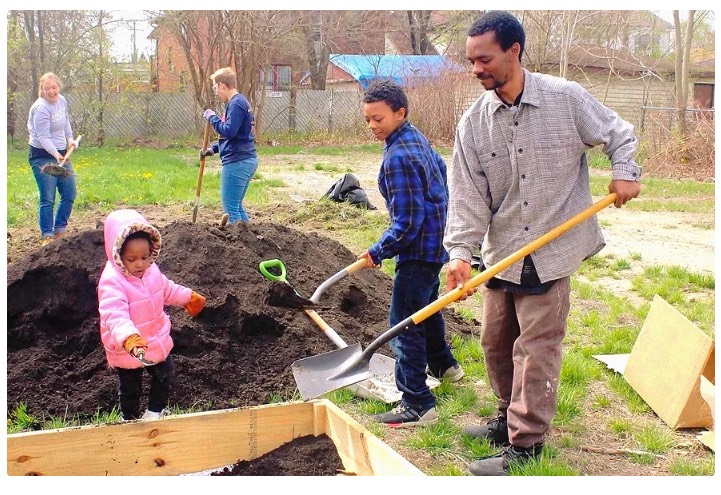
EcoWorks is a nonprofit that works at the intersection of community development and sustainability. Based in Detroit, EcoWorks serves residents, households, community organizations, businesses, and municipalities, working to create just, equitable, and inclusive solutions to climate change. SBN Detroit spoke with Briana DuBose, EcoWorks executive director, to find out more. Q: Tell us about EcoWorks A: EcoWorks is a Detroit-based nonprofit that addresses climate change by enabling Michigan communities to be more environmentally and economically sustainable. We provide transformative climate and sustainable solutions for communities that are underserved and often unseen and unheard. We do this through community development, green consulting, home energy assistance, climate advocacy, education, and workforce development. Our Eco-D program is an equitable approach to securing affordable, healthy resilient homes and neighborhoods. We design and advocate solutions that promote utility affordability, housing security, climate resilience, and resident-led neighborhood development. We also work to engage community members to be part of learning about sustainability and provide direct service programs, upgrades and repairs, and more for underserved communities. Currently, we are working with four areas in Detroit – Hope Village, Southwest, Berg-Lahser, and Yorkshire Village to build out EcoDistricts. We offer comprehensive resources to help these areas transition to decarbonization and electrification. The program also provides residents and community organizations with resources to achieve healthy, affordable, resilient, and energy-secure homes and neighborhoods. Q: How do you work with Detroit neighborhoods and communities specifically? A: We look at ways to ensure the health and safety of all households. We focus on disadvantaged communities working with people who are vulnerable to the impacts of climate change – for example air quality. We partner with coalitions to improve policy and design innovative financial models for healthy, green, housing and neighborhoods. An example of this is River Rouge, which is surrounded by multiple plants and therefore has poor air quality. We go in and have workshops to discuss sustainability and energy-saving measures in their area. People are often surprised that asthma can be caused by poor air quality. We will go in and perform needs assessments on homes and work toward proper sealing and weather stripping and filters so the residents can have clean air in their homes. We also work with the communities in a bigger way to do things like build rain gardens, create green spaces, and more toward the things the specific areas need. Q: How does the Strategic Community Initiatives Program work? A: We develop custom-fit climate and energy solutions for municipalities, school districts, health systems, small businesses, and nonprofits. SCI has secured over $5 million in clean energy investments and over $30 million in lifetime savings for over thirty Michigan municipalities. EcoWorks serves as the lead technical provider as part of the Sacred Spaces Clean Energy Grants, eliminating disproportionate energy burdens for low-income congregations, inclusive of Black, Indigenous, and People of Color (BIPOC) communities statewide. Eleven houses of worship in low-income Michigan neighborhoods from Detroit to the Upper Peninsula will become more energy efficient with support from this $1.24 million grant of federal funds through the Michigan Department of Environment, Great Lakes, and Energy (EGLE) to make improvements that reduce their consumption of fossil fuels for electricity, heating, and cooling. From this, we expect the congregations to achieve a 15% energy savings that will go back into the communities. Q: How can a business in Southeast Michigan take advantage of EcoWorks? A: We bring a unique blend of people and change-management skills coupled with technical assessment and project management capabilities to businesses. Contact us and we’ll set up a meeting to talk. We can develop and manage holistic energy and climate action plans collaboratively for organizations. Q: How do you think EcoWorks impacts Southeast Michigan businesses? A: EcoWorks can help organizations stay nimble and resilient as energy costs and climate impacts rise. We can develop energy plans and implement energy projects by engaging people and bringing them together. We are often conveners. We are on the front line in communities, and we go into businesses to discuss how they may be contributing to the environment and sustainability in their communities. Often, businesses don’t know where to begin or may think sustainability initiatives are going to be expensive. We help educate them and show the ROI. Most businesses want to leave a better footprint on their community; they just need the resources to do so. Q: What are the biggest opportunities EcoWorks represents for Detroit? A: While our roots are firmly planted in energy conservation, we have grown to emphasize all aspects of sustainable development as it relates to building affordable, energy-efficient residential housing and commercial buildings. We are committed to promoting environmental equity and we take pride in helping communities get there. Be sure to subscribe to our newsletter for regular updates on sustainable business practices in and around Detroit.
Daimler Truck’s Detroit Manufacturing Plant – From Diesel to EVs
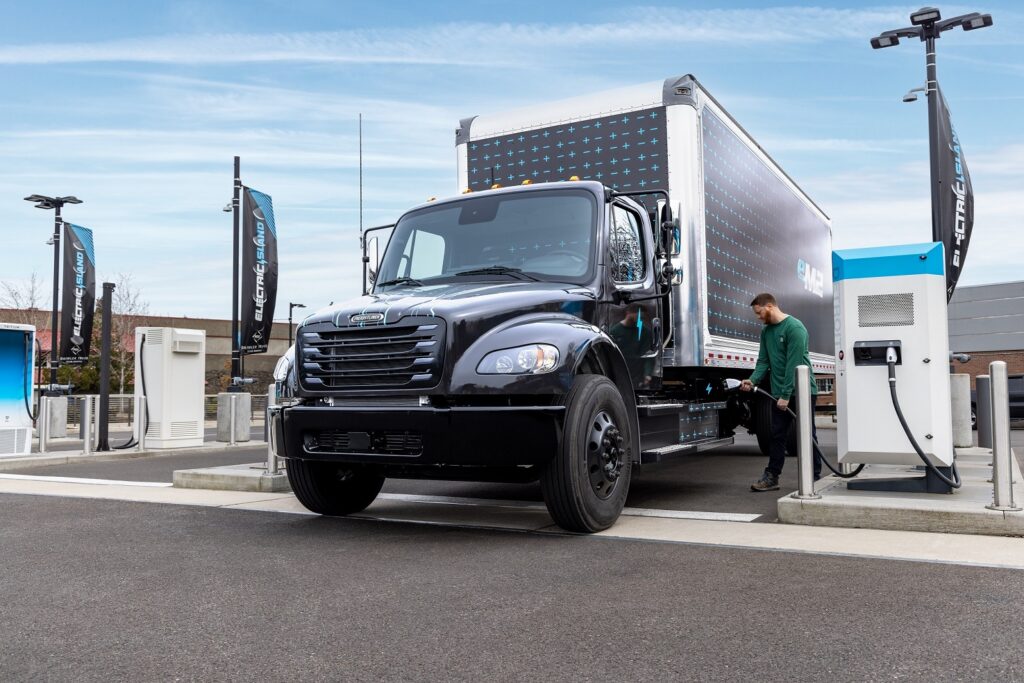
Daimler Truck’s Detroit® Manufacturing Plant produces 400 engines, 250 transmissions, and 1,300 axles daily. The 85-year-old factory is known for making diesel engines but is now working to be a leader in the transition to sustainable transportation. SBN Detroit interviewed Apoorva Mathur, remanufacturing – “reman” – electric product strategy analyst for Daimler Truck North America about the remanufacturing, reuse, and recycling side of the business. Q: How do you approach electrification? A: Our goal is to provide the ePowertrain solution that leads the transition to sustainable transportation. Everything we do pushes toward promoting sustainable transportation. Q: In your role, you focus on the sustainability of Battery Electric Vehicle (BEV) Powertrain components through remanufacturing, reuse, and recycling. How does this work? A: Clearly, part of leading the transition to sustainable transportation is providing an option that has zero emissions, but from an aftermarket perspective, it’s important to be conscious about what we do with components once they come out of the truck. We work to reuse as many components as possible through the remanufacturing process so that we are recycling what we already have. A battery has a lifecycle that extends way beyond what is usable in a vehicle, so to use that battery responsibly it has to have secondary applications. Many times, batteries that come out of a vehicle are used for peak shaving. Peak shaving is utilizing a battery storage system during peak energy usage hours to offset the amount of energy being pulled from the main grid. This reduces the load on the grid. Used batteries can also be used in a microgrid solution whereby some kind of solar or wind-powered system is connected to a battery storage system and energy from solar is used to power the batteries. This is a self-contained situation that does not rely on the grid system at all. Companies can also build used batteries into chargers to provide backup power. So, there are different ways batteries and components can be remanufactured and reused. The recycling component is pretty straightforward. We have a recycling program and a company that disposes of batteries and materials responsibly and also recycles material back into the supply chain. Q: In your role, you also support special projects that advance battery electric vehicle (BEV) adoption, such as creating a charging hub at your Redford location. Can you tell us more about that? A: Yes. The state of Michigan secured $13 million in funding in partnership with Daimler Truck North America and DTE Energy to develop the mobility charging hub earlier this year. We will build a multimodal charging hub there, helping companies to transition their fleets. The charging hub will support heavy trucks and also passenger vehicles and more with the intent to help the entire community transition to EVs. Q: What is driving your change to electrification? A: The largest driver is a combination of emissions standards becoming stricter and also a greater focus on sustainability as a whole on the global stage. Daimler Truck is committed to the Paris Agreement globally, and we are doing our part to provide our customers with zero-emission options. Daimler Truck as a whole is looking for what best suits our customers’ needs, and we are electrifying products across the board and will continue to go down that path. We are also looking at other options such as hydrogen. We need to explore everything to ensure we are giving the best options to our customers. Q: What drives your passion for what you do? A: This is so new for all of us. I’m constantly learning. We are faced with something new every day when comes to requirements from a regulatory perspective and we are constantly getting customer feedback. It’s unchartered territory for all of us and we are all taking this learning journey together in this industry. That’s fun for me. It’s not the business as usual that Detroit Diesel has been doing for 85 years. It’s new and different and exciting. Q: What are the biggest challenges? A: Again, it’s unscripted. It involves so much effort as an industry to make this switch. We can build the product, but we also need the infrastructure. There are gas stations on every corner but supporting EVs is brand new. Also, we need support from utilities. Grid support requires more resiliency as we switch, and there is a lot of work to be done here. When we say we are transforming the transportation industry we mean it. We are taking every component and turning it into something different and it requires so much from everyone. Q: What are the opportunities? A: We’ve seen a whole new level of energy and innovation coming from all sides. New suppliers and players coming into the space every day. It’s exciting to see these companies coming into the industry to push and innovate. On the infrastructure side, it’s the same. New data companies are looking at how to use power in areas to help the grid. There are new charging management systems, new charging suppliers, etc. It’s given the industry a chance to innovate and go outside the norm of what we provide. Q: How do you think the work you are doing impacts Southeast Michigan in terms of innovation? A: Detroit is the place to be when it comes to sustainable transportation. And Detroit is the hub for all things mobility. The Battery Show North America is in Detroit each year, and there is so much knowledge at that show. It’s all being done here. Detroit is the center of competency. It’s a great place to learn and innovate and partner and work within. Q: What does the future look like? A: We will see change on the roads around us. Electric cars are growing in production and adoption in this area. We will see different types of technology being used for different applications as we learn what’s effective. We will see a mixed mobility strategy across the board and that’s exciting. I also
Wayne State University Moves Ahead As a United Nations Regional Center of Expertise
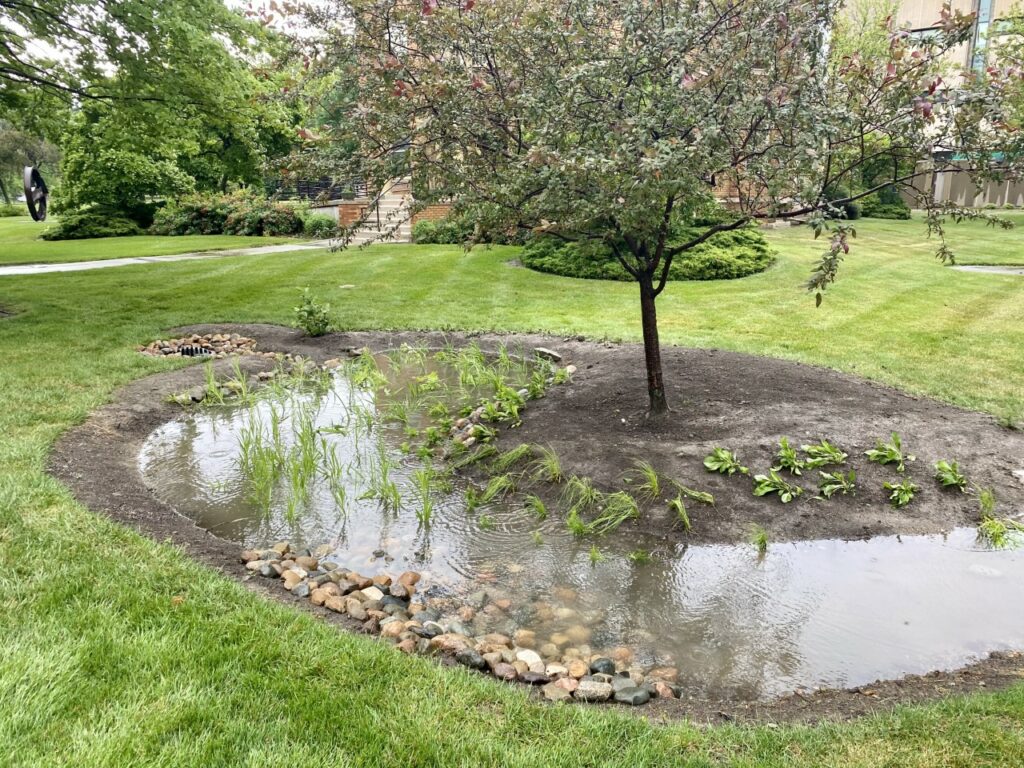
In April 2022, Wayne State University and the University of Windsor were designated as the United Nations Regional Centre of Expertise (RCE) on Education for Sustainable Development in the Detroit-Windsor region. RCEs are networks of educational institutions, communities, governments, businesses, and other organizations that work together to advance and implement sustainability education within a region. SBN Detroit talked with Donna Kashian, Wayne State University professor and director of Environmental Sciences, who is leading the efforts at the university. Q: Tell us about regional centers of expertise. A: The RCE is a global program. Our designation is somewhat unique in that we are binational. In our case, the US and Canada focus on the shared legacy of the region. The waterway is deeply linked to industry and economics in our area, and the two nations face similar challenges. We’ll work toward enhancing the economy to meet the sustainable era. This involves a large set of goals with a foundation in education. Part of our work is to bring together community partners and address activities related to sustainable development challenges. So, we are connecting entities such as the Windsor-Detroit Bridge Authority, key individuals within schools and universities, the government, municipalities, and nonprofits to work on collaborative projects toward our goals. Ultimately, we will utilize these partnerships and networks to support research, training, and participation to move sustainable education forward. Q: How is this set up? A: Wayne State University has been very supportive of this effort and has contributed several resources, including support for two graduate students who will serve as sustainability ambassadors to help move things forward. Through the UN RCE, we are in the process of forming a sustainability council. We are appointing an individual from every unit within the university to report back to this council. Additionally, we will also have an external advisory board to help identify sustainability challenges in the Southeast Michigan region and the Essex region. The fellows will start tackling research and projects that are identified. Q: I understand that the goal of the UN RCE is to identify actions that address climate change, economic and health disparities, and social inequity to create a more sustainable future. How will you approach this? A: This is incredibly broad-sweeping and each university will tackle projects differently. WSU just launched a new five-year sustainability plan, and environmental justice and social inequity are addressed throughout. Many universities don’t include these front and center in their plans, so in this way, I think we can work as an example to advance university sustainability planning as a whole. Regarding climate change, we recently submitted a $3 million project to tackle climate resilience and flooding – that involves infrastructure and design – in addition to many projects in the community and education around that, which include talking to local middle and high school children. Two of my students and I have an upcoming visit to 6th-grade classes to educate young people on climate change. So our work involves projects, traditional research plus community education. Q: What are the benefits to students? A: Approximately six years ago WSU applied for and received a training grant in urban sustainability which initiated our T-Rust (Transformative Research Urban Sustainability Training) program. This program is wrapping up and has transitioned into the UN RCE. This program supported 33 graduate students and, to date, ten have graduated with seven master’s degrees and three doctorate degrees. Two of these students have been chosen to work on research and science policy on Capitol Hill. We are training future leaders, and they are walking into really great positions. The UN RCE designation will help us step into undergraduate opportunities as well, so we can reach more students and start training at an earlier stage. When the students hear the United Nations designation their ears perk up and are anxious to get involved. Watching the grad students go on to succeed and being able to extend more opportunities to undergrads is huge. Q: How will this work potentially impact Southeast Michigan businesses? A: This is one of our big agenda items. Typically, the environmental side of the university, where most of my connections are, has not been as connected as it could be to the business side. We’ve been working in silos. So we are working to form partnerships and do a better job at this. Q: What other things are you involved in around sustainability? A: I serve as a US representative for the International Joint Commission’s science advisory board, and next year will serve as president of the International Association of Great Lakes Research (IAGLR). I also am on the Conservation and Environmental Issues Committee – Society of Fresh Water Science, and the Inclusion, Diversity, Equity, and Accessibility+ Committee (IDEA+) committee for IAGLR. Q: How do these things help drive and shape your work overall? A: I think it all ties together. People say I’ve taken so much on, but it’s all interconnected and I think it’s about centralizing the work, not creating more. It’s all focused on the health of the Great Lakes and environmental justice. I hope to use and bring my shared resources to the UN RCE. Q: Where does your passion come from? A: Growing up, I lived in a Portuguese community in Massachusetts that has a long history of pollution from the textile industry. My family has an extraordinarily high cancer rate. I’ve always loved being outside, and I’ve always been passionate about improving health. I think my drive started there. And then five years ago, I was diagnosed with cancer myself. That has pushed me. The drive was there, but I now have an even stronger desire to push forward. Q: What is the end game? A: To live in a society that is just from a sustainable perspective, and to live within a healthy climate and environment. We clearly cannot accomplish this through the UN RCE alone, but we can move the dial. Training our youth to continue the quest and vote
Delta: Working Toward Net Zero Through Sustainability, Climate Impact
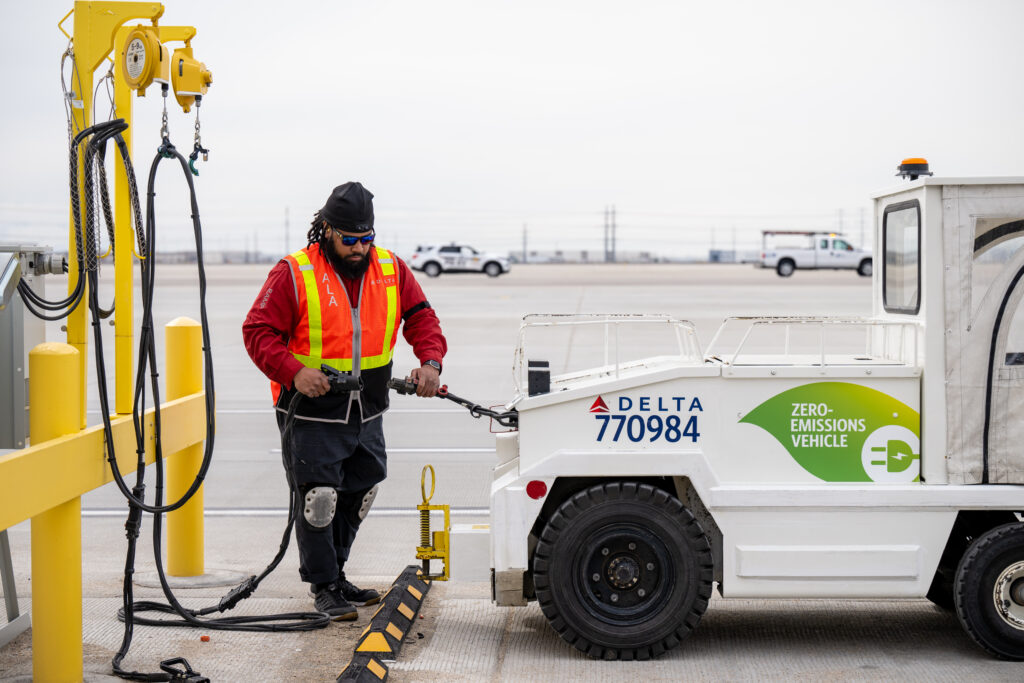
Delta Air Lines employs 95,000 people and operates 4,000 flights a day, flying to more than 280 destinations on six continents, and expects to serve nearly 200 million customers this year. 13.7 million passengers flew in or out of Detroit Metro Airport in 2022, making it Delta’s third-largest hub. We interviewed Gail Grimmett, Delta’s senior vice president of sustainability performance and strategic partnerships, to learn more about the airline’s sustainability strategy. Q: How does Delta approach sustainability? A: We are on a journey to reach net zero by 2050, so we have milestones and smaller goals we are working toward for 2025, 2030, and 2035 to help us get to net zero. Our goals fall into two main pillars. The first is to embed sustainability in everything we do. This allows us to concentrate on things we can control today and allows sustainability to penetrate the entire business. The second is to eliminate our climate impact from flying. This is where our fuel and fleet come into play. So, we focus on these two main pillars and have set key targets and goals for each. Q: What does your sustainability team look like and how is it organized within the company? A: It’s set up to support the pillars. We have councils set up across the organization that work toward our goals. For example, we have a Carbon Council that is led by our chief of operations. This group is focused on innovation and fuel usage, looking for fuel efficiencies and savings Last year we saved 10 million gallons in fuel by weight reduction and by flying in a more efficient manner such as altitude and speed. We have sustainability embedded across the organization working on finding efficiencies and opportunities in areas we can control today. Q: Is sustainability addressed any differently here? A: All airports are different, but because we have great partners with the Airport Authority, we’re able to make changes outside of just our operation, like with LED lighting, low-flow water within the terminal, and within our catering kitchens. Since Detroit is a hub, it is a key airport for us that we look at regularly. We’ve been working on electrifying our ground service equipment (GSE) to convert to 100% electric by 2025 in five of our hubs and 100% in all of our hubs by 2035. Q: What are your short-term sustainability goals? A: In the short term, we are focusing on what we can control within our operation. For example, leveraging our councils to reduce fuel usage by another 10 million gallons this year. By 2035 we expect the Carbon Council to have saved 1.1 billion gallons of fuel, which is important from both a cost and emissions perspective. We are eliminating single-use plastics from planes. We eliminated 4.9 million pounds of plastic from planes as of last year, and on Dec. 5, we announced a new paper cup that we are testing in-flight that once fully rolled out will eliminate another 7 million pounds of single-use plastic. Changes like a new paper cup are no easy task. These cups must handle both hot and cold materials and meet international regulations that can vary from country to country. We’re a global airline, and, operationally, we can’t just stock every aircraft differently based on the countries they travel through. We have to satisfy the sustainability regulations of all countries on all planes. Q: What about longer-term goals? A: We need to be net zero by 2050. That is the goal everyone in the industry is racing toward. To accomplish this, we need to focus on large-scale changes – things like switching to sustainable aviation fuel and hydrogen to power aircraft and building the supporting infrastructure. All this is still being researched and tested. When we think about our fleet – what we fly and how we fly – we are looking at what we can do in the medium term and the long term. For example, each new aircraft we add to our fleet generates around 25% fuel savings, so we are also updating our fleets to be more efficient. Q: What else are you working on to get to net zero by 2050? A: The number one lever we can pull to decarbonize our industry is sustainable aviation fuel (SAF). Currently, there is not enough of it, so we need to ramp up production of it. Today, there is only enough SAF to barely cover one day’s worth of flying for the entire industry. The government and policymakers are important as the production of SAF scales because we need the right policies and incentives to increase production and build the infrastructure to support SAF. While that may seem daunting, a positive is that SAF is an immediate solution – it can be added directly into planes right now. So, while there isn’t enough of it, it can be blended with current fuel, so we can start with 50% SAF and move to 80% and then 100% as the production ramps up. Also, this first-generation SAF won’t be the last. It will continue to evolve. This is one of the most exciting times to be in this field as there is so much need here, and so much innovation happening. Q: I read that you focus on building your fleet to have the longest, most sustainable life possible. Can you tell us more about that? A: Circularity is important to us. We look at refreshing planes, regenerating materials, and recycling. We hold onto our fleet for a long time but continually look at how to be more efficient with the fleet. Adjustments are being made to certain planes to reduce drag, which helps them become more fuel-efficient. This goes back to controlling what we can control while continuing to refresh the fleet as we can. Q: What are the biggest challenges overall? A: There are two. The first is the pace of technology advancement. It needs to speed up and I think it will. And,
This Month’s Message from Terry Barclay, SBN Detroit chair and CEO of Inforum
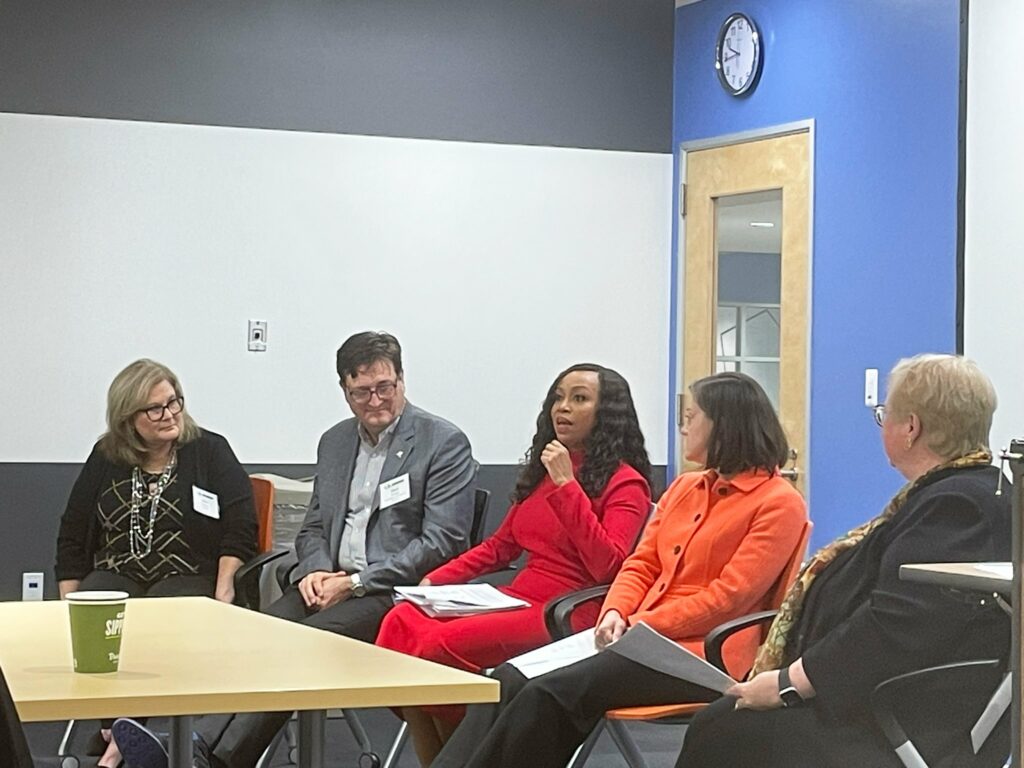
On Oct. 31, SBND hosted a panel focusing on business and sustainability in the Great Lakes region. The event was a collaboration with the Council of the Great Lakes Region and featured Shanelle Jackson, senior manager, LyondellBasell; Edna Lorenz, energy director, Corewell Health; Mark Schrupp, executive director, Detroit/Wayne County Port Authority; and Lillian Woolley, senior chemical engineer, Fishbeck. It was a fascinating discussion, and I encourage you to read the story here. Before the panel discussion, Colin Bird, counsel general of Canada in Detroit, spoke about how Canada and the U.S. work together on issues that include the environment, maritime trade, and stewardship of the Great Lakes. In Michigan, we are more aware of this than most in the U.S., but some of the specifics were new to me. Some examples: In 2022, Canada was the U.S.’s largest trading partner in goods and services. About 80% of Canadian goods exports to the U.S. ‘feed’ American supply chains for final goods. According to U.S. trade data, in 2022, bilateral trade in goods and services was US$914.3 billion, representing over US$2.5 billion worth of goods and services crossing the border every day. The joint stewardship of the environment is a cornerstone of Canada-U.S. relations, from air and water quality to wildlife management. This includes at least 50 federal bilateral arrangements, more than 100 arrangements at the state and provincial level, and the Boundary Waters Treaty of 1909. The Canada-U.S. Joint Action Plan on Critical Minerals Collaboration and the Memorandum of Understanding (MOU) expand energy cooperation between the two countries are some examples of collaborative initiatives. Canada’s 2023 federal budget allocates $650 million over ten years to support monitoring, assessment, and restoration work in key freshwater ecosystems, many of which are shared by Canada and the US. Of this total, $420 million will go towards restoring and protecting the Great Lakes, complementing significant U.S. efforts in this regard. On September 18, the University of Michigan announced an award of $5 million from the National Science Foundation to establish the Global Center for Understanding Climate Change Impacts on Transboundary Waters, comprised of U.S. and Canadian universities and Indigenous representatives. McMaster University will lead the Canadian side, with $3.75 million in funding provided by the National Science Foundation. More trade statistics specific to Michigan can be found here. Be sure to subscribe to our newsletter for regular updates on sustainable business practices in and around Detroit.
